Can someone help me ? How can I add my circos function in my data? when i try i get an error message and it doesn't produce any results I want to do a donut figure like the representation number 1 but i have one other resultat that we can see in the other picture. Trying to follow this guide

My data is lile this :
Name;Integrons_1;Integrons_2;Integrons_3;TEM;SHV;CTX_M;NDM;OXA_48
HZ1410;1;0;0;1;1;0;1;1
HZ0411;1;0;0;1;0;0;0;1
WI1410;1;0;0;1;1;0;0;1
WI0411;1;0;0;1;0;0;1;0
FR1410;1;0;0;1;0;0;0;0
FR0411;0;0;0;1;1;0;0;0
CN1410;1;0;0;1;1;0;1;0
CN0411;1;0;0;1;0;0;0;1
SA0912;0;0;0;0;0;0;0;0
SA0302;1;0;0;1;0;0;0;0
BL0912;1;0;0;1;1;0;0;0
BL0302;1;0;0;1;1;1;0;1
CSI0912;1;1;0;1;0;0;0;1
CSI0302;1;0;0;1;1;1;1;1
CSII0912;1;1;0;1;0;1;1;0
CSII0302;1;0;0;1;0;0;0;0
BGI0503;1;1;1;1;1;0;0;0
BGI0610;1;0;0;1;1;0;0;0
BGII0503;1;1;1;1;1;0;0;0
BGII0610;1;0;1;1;1;0;0;0
BCI0503;1;0;1;1;1;0;1;1
BCI0610;1;0;1;1;0;0;0;0
BCII0503;1;0;1;1;1;0;1;0
BCII0610;1;0;1;1;0;0;0;0
BDI0503;1;0;0;1;1;0;0;0
BDI0610;1;1;1;1;1;1;1;0
BDII0503;1;0;1;1;0;1;0;0
BDII0610;1;1;1;1;1;1;0;1
YPI0503;1;0;1;1;0;0;0;0
YPI0710;1;1;1;1;1;1;0;1
YPII0503;1;0;1;1;0;0;0;1
YPII0710;1;1;1;1;1;1;0;0
YMI0503;1;1;1;1;1;0;1;0
YMI0710;1;1;1;1;1;1;1;1
YMII0503;1;1;1;1;1;0;0;1
YMII0710;1;1;1;1;1;1;1;1
YSI0503;1;1;0;0;1;0;0;0
YSI0710;1;1;1;1;1;1;1;1
YSII0503;1;1;0;1;1;0;0;0
YSII0710;0;1;1;1;1;0;0;0
And my code is represented here:
#### IMPORT DES DONNEES ####
nba = read.csv("essai_r.csv", sep=";", header=T)
#attention : toujours utilise le format csv avec le sep = ";" pour avoir de
#beaux tableaux
#### INSTALLATION DES LIBRARY ####
library(reshape)
library(ggplot2)
library(plyr)
library(circlize)
#### CREATION DES TABLEAUX : FCT MELT ####
nba$Name <- with(nba, reorder(Name, GES))
nba.m <- melt(nba)
#pas utilise car ce n'est pas ce que je veux
#nba.m <- ddply(nba.m, .(variable), transform, value = scale(value))
#### MODIFICATION DES DONNEES : FACTOR -> NUMERIQUES ####
# Convert the factor levels to numeric + quanity to determine size of hole.
nba.m$var2 = as.numeric(nba.m$variable) + 15
# Labels and breaks need to be added with scale_y_discrete.
y_labels = levels(nba.m$variable)
y_breaks = seq_along(y_labels) + 15
#### CREATION DE LA HEATMAP (DEGRADE DE COULEUR UNIQUEMENT) ####
p2 = ggplot(nba.m, aes(x=Name, y=var2, fill=value)) +
geom_tile(colour="black") +
scale_fill_gradient(low = "beige", high = "red") +
ylim(c(0, max(nba.m$var2) + 0.5))
scale_y_discrete(breaks=y_breaks, labels=y_labels) +
coord_polar(theta="x") +
theme(panel.background=element_blank(),
axis.title=element_blank(),
panel.grid=element_blank(),
axis.text.x=element_blank(),
axis.ticks=element_blank(),
axis.text.y=element_text(size=5))
ggsave(filename="plot_2.png", plot=p2, height=7, width=7)
#sauvegarde le fichier dans le dossier
circos.par(start.degree = 90, gap.degree = 10)
#### CREATION DE LA HEATMAP BIS (AVEC NOMS DE SITES )
nba.labs <- subset(nba.m, variable==levels(nba.m$variable)[nlevels(nba.m$variable)])
nba.labs <- nba.labs[order(nba.labs$Name),]
nba.labs$ang <- seq(from=(360/nrow(nba.labs))/1.5, to=(1.5*(360/nrow(nba.labs)))-360, length.out=nrow(nba.labs))+80
nba.labs$hjust <- 0
nba.labs$hjust[which(nba.labs$ang < -90)] <- 1
p3 = ggplot(nba.m, aes(x=Name, y=var2, fill=value)) +
geom_tile(colour="black") +
geom_text(data=nba.labs, aes(x=Name, y=var2+1.5,
label=Name, angle=ang, hjust=hjust), size=3) +
scale_fill_gradient(low = "beige", high = "steelblue") +
ylim(c(0, max(nba.m$var2) + 1.5)) +
scale_y_discrete(breaks=y_breaks, labels=y_labels) +
coord_polar(theta="x") +
theme(panel.background=element_blank(),
axis.title=element_blank(),
panel.grid=element_blank(),
axis.text.x=element_blank(),
axis.ticks=element_blank(),
axis.text.y=element_text(size=5))
nba.labs$ang[which(nba.labs$ang < -90)] <- (180+nba.labs$ang)[which(nba.labs$ang < -90)]
#### Representation graphique ####
p3


